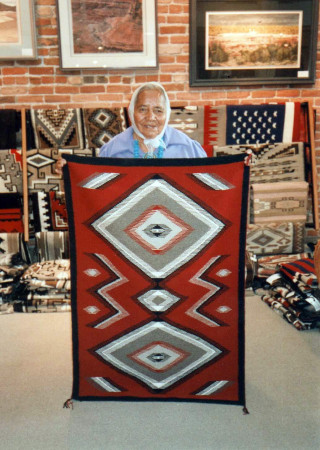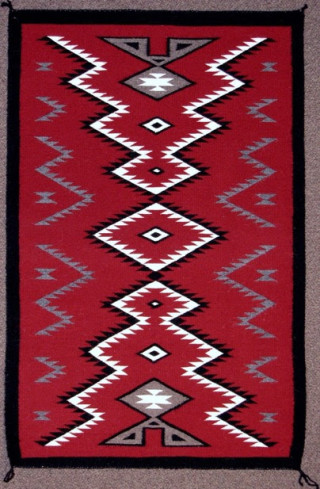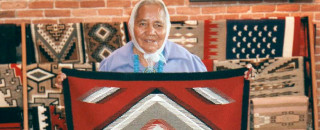Mary Reid: A Ganado Weaver
Mary Reid, A Ganado Weaver, 1921-2004
By Jackson Clark II, first published on the Toh-Atin Gallery blog
Prior to 1983, when we still operated our Navajo rug business out of the front office of our father’s Pepsi Cola business in Durango, it was a common site to have a pickup truck pull up in front of the bottling plant and see an older Navajo woman emerge with a Navajo weaving rolled up in a Blue Bird flour sack.
When a weaver walked in to my Dad’s office, everything else stopped. He would get everyone in the group a Pepsi and they would catch up on the family stories. Salesmen, bankers or anyone else that was there to do business with the Pepsi company had to wait. The weavers came first.
One of the oldest weaving relationships that I can remember was with a woman named Mary Reid. She was from Ganado, Arizona and was an imposing figure. Mary was a short, large woman, with a beautiful smile, a great sense of humor, and the ability to weave beautiful, simple rugs, both large and small. Although most of her rugs were in the primary Ganado colors or red, black, grey and white, she also excelled at vegetal dye pieces; not a common ability.

Mary was related to Mae Jim, Sadie Curtis and several other Ganado weavers, but I never was able to understand how. The Navajo have a complicated clan and family system and sometimes it can get a little murky for those of us on the outside. She spoke no English and always had a family member with her to translate which did not inhibit the conversations we would enjoy when she brought her weavings to Durango.
When Dad and Mark Winter were putting together the “Durango Collection of Southwestern Textiles,” which is now at the Center for Southwest Studies at Fort Lewis College, their choice for a spectacular Ganado weaving for the collection was one of Mary’s pieces.
Mary passed on in 2004 and during her last years she could no longer weave really large rugs, but she had no intention of quitting.
Like many of the older weavers, her work at the loom kept her vibrant and living.
We are very lucky to have two of the last pieces that Mary wove in our inventory now. We originally sold both of these weavings and, like old friends, it was wonderful to see them come back to us for resale.
One is a gorgeous vegetal dye piece and the other is a classic, simple Ganado Red. I remember buying both weavings from her. Mary’s son, Ronny, would call and say, “Mom has another rug. Do you want it?”
I was always amazed that he had to ask, but it was just a part of his family’s polite nature. I’m sure he knew we would never say no!
By that time, Mary was having a hard time walking and it was difficult for her to make the trip from the reservation, but she wouldn’t miss it! She was proud of her work and enjoyed the opportunity to visit and share time with Ronny, who always took the day off from his job to bring her to Durango.
These two pieces were among the last that Mary wove. They are exceptional, small examples of her work and worthy of any collection.
Mary was one of those people that you meet and work with in life and never forget. Just having these weavings again has brought back wonderful memories.


Jackson Clark is the owner of Toh-Atin Gallery in Durango, Colorado and friend of The Natural History Museum of Utah. Clark is a recognized expert in Native American art and Navajo weaving and regularly gives talks to museums and organizations across the country. NHMU is a part of the University of Utah in Salt Lake City. Our mission is to illuminate the natural world and the place of humans within it. In addition to housing outstanding exhibits for the public, NHMU is a research museum. Learn more.
